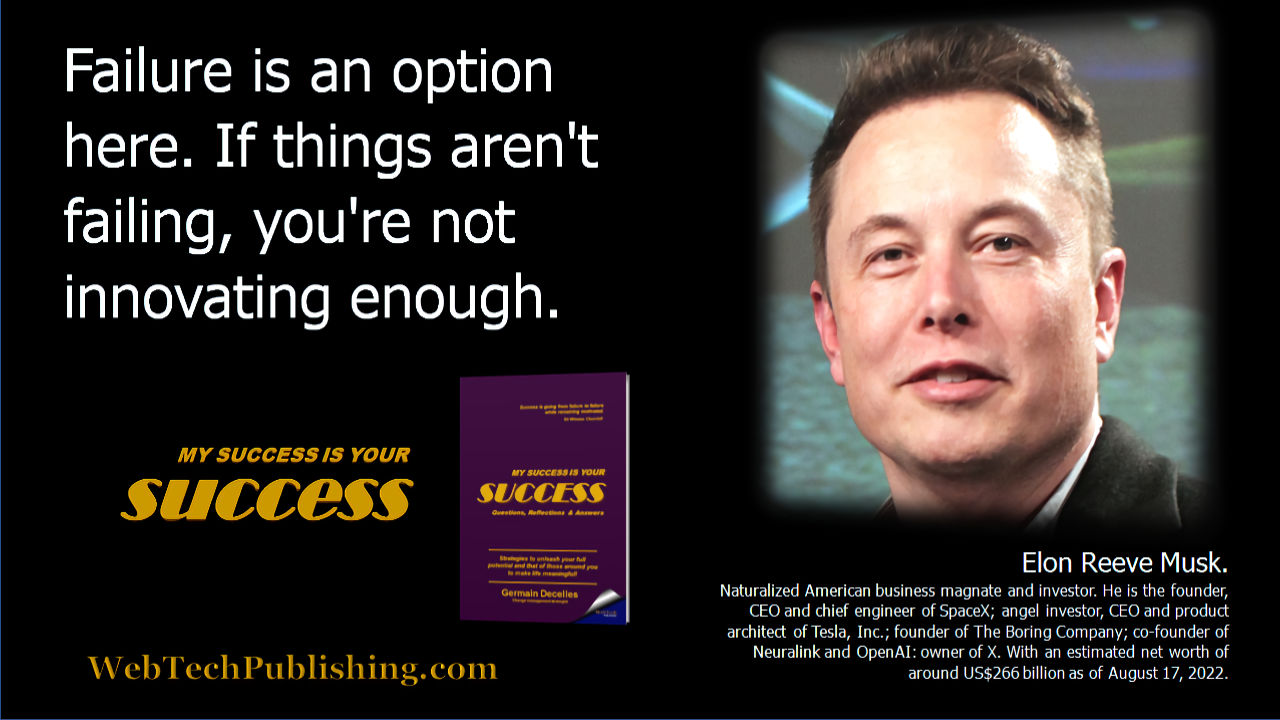|
Article published on LinkedIn.com:
April 12, 2024
34_innovation_En.pdf

The quotations, short texts, and photographs in this
work remain the exclusive property of their respective
authors.
INNOVATION
Creativity and innovation are two related but distinct
concepts, and each is necessary for success. Creativity does
not lead to inventions and growth, but to innovation.
However, innovation does not happen without creative people.
Generating creativity means allowing people to think outside
the box and sometimes go against the norm.
If you let bureaucracy stifle creativity, innovation will fall
victim, leaving your competitors to push forward with new
market share.
1.
What is innovation?
Innovation is the
implementation or creation of something new to realize value.
Innovation most materializes as a tool, physical advantage, or
aid that solves a problem or creates an advantage.
Types of innovation:
There are several dozen types
of innovation framework; here we present the three major
categories of innovations that promote the process of
creativity and innovation that can partly or wholly be used or
adapted to economic sectors, to social and governmental
organizations:
·
The economic model:
Focused on internal management, these configuration
innovations analyze how an organization operates and generates
revenue. These can pose a higher risk, as they sometimes alter
fundamental decisions on which organizations are built.
For example, business model innovations are best pursued when operators
identify oversaturated markets, low customer satisfaction, or
outdated technology.
·
Products and services:
Whether tangible or intangible, innovations in products,
services, or a combination of the two improve existing goods
in some way. For example, smart phones, pharmaceuticals,
wireless headphones, or new financial services.
·
Commercialization:
marketing innovation creates
new markets or increases existing market share. Marketing
innovations are positively disruptive new ways for brands to
interact with consumers. Not only can market innovation
introduce a new way to connect with audiences, not only it can
be as simple as promoting an existing product for a different
use than originally intended.
An innovation makes a
demonstrable, often disruptive, difference in a product,
service, industry, and social or governmental organization.
This is a fundamentally new and tangible change and departure
from the conventional.
2.
Why don't we innovate more?
A lot of people who are full
of ideas just don't understand how an organization should work
to get things done, especially radically new things. Too often
there is the strange underlying assumption that creativity
automatically leads to true innovation.
This type of thinking is a
particular disease of « brainstorming » proponents, who often
treat their approach as some sort of ultimate business
liberator.
The process of forming and
linking ideas and innovation are not synonymous. The first
type deals with the generation of ideas and the second with
their implementation.
To avoid confusion, it is not
essential that the innovation be successfully implemented to
be considered an innovation.
The object of innovation is
success, but to demand in advance that there be no doubt of
its success would negate its chance of ever being tried.
Here, it must be understood that there
are many people who are overflowing with ideas, but who simply
do not understand how an organization must operate to get
things done.
It's not about putting a dozen
inexperienced people in a room and conducting a brainstorming
session with the goal of producing exciting new ideas for
ideas to spring up and come to fruition.
Rather, bring together people who have
an open mind, the know-how, the energy, the audacity, and the
stamina to implement ideas.
Whatever the objectives of a business,
it must make money. For that, we have to move things forward.
But having ideas rarely equates to getting things done in a
business or organizational sense if they don't become
innovations.
Ideas are not implemented in business
or in art, science, philosophy, politics, love, war, if there
are not bold people and endurance who concretize them.
3.
A form of irresponsibility:
Since business is only an institution that « gets things done,
» creativity without action-oriented follow-through is a
particularly sterile form of individual behavior. In a way,
it's even irresponsible.
This is because first the creative man
who comes up with ideas and does nothing to help them get
implemented shirks responsibility for one of the main
requirements of business, namely action. Second, by avoiding
tracking, it behaves in an organizationally intolerable way or
at best, simple negligence.
The problem that most often emerges
from the creative process today is that many of the people who
come up with ideas have a particular notion that their work is
done once the ideas have been suggested. They think it's up to
someone else to work out the details and then implement the
proposals.
Generally, the more creative, the
person, the less responsibility they take to act. It is that
the generation of ideas and concepts is often their only
talent.
She or he rarely has the energy or the
persistence, or even the interest, to work out the details
that need attention before her or his ideas can be
implemented.
Take the time to observe around you
that there are certain people with ideas that can constantly
sprinkle everyone in the organization, with proposals and
memos that are just brief enough to grab attention, intrigue
and maintain interest without including responsible
suggestions regarding implementation and potential impacts.
In some cases, it must be inferred
that they are using pseudo-novel ideas for their disruptive or
self-promotional value.
It should be emphasized, however, that something favorable can be said
about the relation of irresponsibility to ideation.
Leaders who are generally effective in their role as leaders can often
exhibit what might be called controlled momentary
irresponsibility, recognizing that this attitude is
practically necessary for the free play of the imagination and
hold it back just long enough to be more productive.
4.
The
discontented:
in most
businesses and organizations, you will find people who are
actively dissatisfied with the « here and now » and who are
full of suggestions on what to do about it. They are also
commonly known as corporate or organizational malcontents.
They tend to constantly complain about the senility of
management, its refusal to see the obvious facts of its own
massive inertia. They complain about management's refusal to
do things that have been suggested to them for years.
They often complain that management doesn't even want creative
ideas because the ideas disrupt the running of the business.
They will even insinuate that management, by their inertia,
slowly leads to the ruin of the enterprise.
In short, they speak of the business or organization as a
festering sore of deadly conformity, full of rotting
vegetables who systematically oppose new ideas against ancient
ideologies.
For your success and the success
around you, it is important to identify these individuals, to
ensure that one of them does not torpedo you.
Also, when appropriate, discuss with
management rather than confronting them.
Often, management will be able to take
the necessary measures such as distributing additional
information to reassure everyone.
For the radicals of discontent, more
often than not they shoot themselves in the foot with their
remarks and if they do not take notice, they find themselves
unemployed by their own fault.
5.
Why resistance?
One of the reasons the boss so often
rejects new ideas is because he's struggling with day-to-day
tasks and that he has to manage a constant flow of problems.
In addition, he receives an endless
stream of questions on which to make decisions. He is
constantly forced to deal with problems whose solutions are
more or less urgent and whose answers are far from clear-cut.
It may seem wonderful to a subordinate
to provide his boss with a bunch of new and brilliant ideas to
help him in his job. However, creative advocates need to
understand that the pressing facts of the boss's life take
precedence.
It must be remembered that each time
an idea is submitted to him, he must take the time to examine
it, put it into perspective and then put himself in solution
mode if he thinks that the idea submitted could help the
success of the organization.
6.
Make ideas viable:
ideas are useless unless used. The proof of their value is
their implementation.
Otherwise, they remain in limbo.
To do this, when you suggest an idea,
the responsible procedure is to include at least a minimal
indication of what it involves, in terms of cost, risk, labor,
time, and perhaps even specific people who need to carry it
out.
This is responsible behavior, because
it makes it easier for the boss to evaluate the idea and thus
pose fewer problems for him. This is how creative thinking is
more likely to turn into innovation.
7.
Determining factors:
that doesn't mean that every idea needs careful study before
it's mentioned to anyone. Far from there. Needs vary from case
to case based on four factors.
a.
The position or rank
of the initiator of the idea in the organization: the
level of a person's « responsibility » to act for an idea to
gain a hearing clearly depends on their rank. The big boss can
simply ask one of his subordinates to take and develop the
idea. This is enough to grant him a meeting and, if necessary,
to initiate an implementation.
Similarly, the head of a department
can do the same in his area. However, when ideas are flowing
in the opposite direction, up rather than down, they are
unlikely to flow unless they are supported by minimal guidance
regarding the definition of the idea, inherent costs and risks
and a certain level of communication from the initiator.
b.
The complexity of
the idea: the more complex the implications of an idea and
the more it may require changes and reorganizations within the
organization then obviously the more it will be necessary to
expand the proposal, in responsible ways to receive the
necessary attention.
c.
The nature of the
sector:
The amount of supporting detail a subordinate must submit with
their idea often depends on the industry involved and the
focus of the idea.
For example, one of the reasons why so
much emphasis is placed on « creativity » in advertising is
that the first requirement for an advertisement is to attract
attention.
Thus, « creativity » often revolves
around trying to achieve visual or auditory impact, so that
advertising stands out from the ever-expanding stream of
advertising noise to which the harassed consumer is subjected.
At this point, in the
advertising industry, being
« creativity » is quite different, on the whole, from what it is,
say, in the steel industry. Putting a new logotype on a shirt
is «
No
sooner said than done. »
The idea practically goes hand in hand with its
implementation.
However, in the steel industry,
an idea, for example, to change the price discount structure
to encourage users of cold-rolled steel sheets to place larger
orders is so fraught with complications and potential
problems, that talking about it is not enough to establish
such a discount program.
To get a sympathetic first
hearing, such an idea must be accompanied by a good deal of
factual and logical evidence.
d.
The attitude and
occupation of the person to whom the idea is submitted:
everyone knows that some bosses are more receptive than others
to new ideas. Even, there are some who are more receptive than
others to novelty.
The extent of their known receptivity
will in part determine the elaboration of the support that a
new suggested idea requires at its initial stage.
However, just as importantly, it is
essential to recognize that the greater the pressures of
day-to-day operational responsibilities on the boss, the more
resistance they are likely to have towards new ideas.
It should always be remembered that
the operating burden is on him. The boss's job is to make the
current setup work properly and smoothly.
A new idea demands change and change
upsets the smooth regularity of the current operation
regarding efficiency, on which its professional future
depends.
The boss has very good reason to be
extremely cautious about a new proposal. The latter needs
several good reasons to reduce the risk before considering an
idea very carefully.
In addition, the requirements, he will
have to consider, will also depend on the attitude of his
superiors towards taking risks and making mistakes. For
example, in some organizations, some leaders will have a
higher level of receptivity to novelty and even sometimes the
more out of the ordinary, the better.
Such organizations are rather rare,
because usually business leaders are conditioned by the
environment, and it is extremely difficult for them to refute
the hierarchical order.
However, you will find this wind of
innovation when new leaders with different experiences or from
other backgrounds are parachuted into the organization.
The latter perceive their contribution
more to improve, change and evolve than to maintain habits
that are no longer profitable.
In short, a permissive, open, and
conducive environment for risk taking, cannot be created
simply by the good intentions of senior management.
The reason for this is either that
those senior executives who have risen to their senior
positions through a lifetime of wise executive behavior are
unable to change their habits or that if their habits are
changed, their subordinates will not believe that they really
mean it. And in many ways, they see a vindication of their
skepticism.
e.
The need for rigor:
organization and creativity do not seem to go together, but
organization and compliance do.
The defense of a « permissive
environment » for creativity in an organization is often a
veiled attack on the very idea of the organization. This
quickly becomes clear when we recognize this inescapable fact.
One of the collateral goals of an
organization is to be inhospitable to a large and constant
flow of ideas and creativity.
Whether it is a large corporation or a
large labor group, an army or the Salvation Army, a country
like the United States or the People's Republic of China, the
purpose of organization is to achieve the type and degree of
order and conformity necessary to perform a particular job.
To do this, the organization exists to
restrict and channel the range of individual actions and
behaviors, a predictable and knowable routine. Without
organizational routine, there would be chaos and decadence.
The organization exists to create the
number and kind of inflexibility necessary to get the most
urgent work done efficiently and on time.
Creativity and innovation disrupt this
order. Therefore, the organization tends to be inhospitable to
creativity and innovation, although without creativity and
innovation, it would eventually perish.
This is why small organizations are so
often more lively and « Innovative » than large ones. They
have virtually no organization precisely because they are
one-person businesses and are often run by people who act on
impulse.
Organizations are created to bring
order. They have policies, procedures and rules that are not
directly expressed in a formal way but are well understood.
The work for which, the organization
exists, could not be accomplished without these rules,
procedures, and policies.
These same rules that produce the so-called conformism that is
so cheerfully decried by the organization's critics, and which
seems to disrupt life inside the company.
Remember, where there are enough rules, there will also be
silly rules, those that can be ruthlessly caricatured.
But some rules, which to some experts
seem nonsensical are far from nonsense if they bother to learn
about the problems of the company, the government, or any
other group for which the particular organization of work is
intended to face.
To learn more about how to inspire success, visit WebTech
Management and Publishing Incorporated (www.webtechmanagement.com)
and click on the blue image (Wise whiZ) at the bottom right of
the screen.
|

|
This book is the result of forty years
of experience acquired with local and international
organizations and companies and during consultancy,
change management, transition and marketing services.
This 404-page
personal development book was published by WebTech
Publishing and is available online in English, North
American French and European versions. For more
information and to view the flip book, visit
webtechPublishing.
|
About the Author
Decelles
Other publications:
ISO Pour Tous
– Le manuel
d’information ISO – Le guide de préparation ISO – La
gestion du changement en affaires – La gestion de
projet d’affaires – Le
changement POUR TOUS –
Change your future,
now! – Mon succès est votre succès.
Press Contact
Germain Decelles, o.s.j.
WebTech Management et Publication Incorpored
|
 |
—30 —
|